Sleep isn’t a luxury you can afford to sacrifice—it’s the foundational technology that powers everything else you hope to achieve.
Note: This article is for educational and informational purposes only. See full disclaimer at the end.
Imagine waking up and feeling genuinely switched on—clear mind, steady mood, strong body. That isn’t luck; it’s what happens when you treat sleep like your most valuable technology.
Sleep is the most misunderstood and undervalued system in modern life. In a culture that glorifies “rise and grind,” sleep gets framed as lost productivity instead of the biological power plant that restores, repairs, and optimizes your entire system. The cost isn’t just feeling groggy—it shows up in your hormones, immune function, metabolism, memory, and mood.
Matthew Walker, professor of neuroscience at UC Berkeley and author of Why We Sleep, has spent decades mapping how sleep touches human health [9]. He reports that routinely sleeping less than six or seven hours can demolish immune defenses and is associated with sharply increased disease risk [8]. Sleep loss is linked to major chronic conditions across the developed world [8].
This piece isn’t about fear—it’s about engineering. You’re going to turn sleep from a biological necessity into a strategic advantage: understand the architecture, align it with your circadian clock, design the environment, and operationalize nightly routines that compound.
Think of yourself as the chief engineer of a living system. Every tweak you make tonight — from the way you set your lights to the timing of your workouts — is another line of code in the operating system that runs your body.
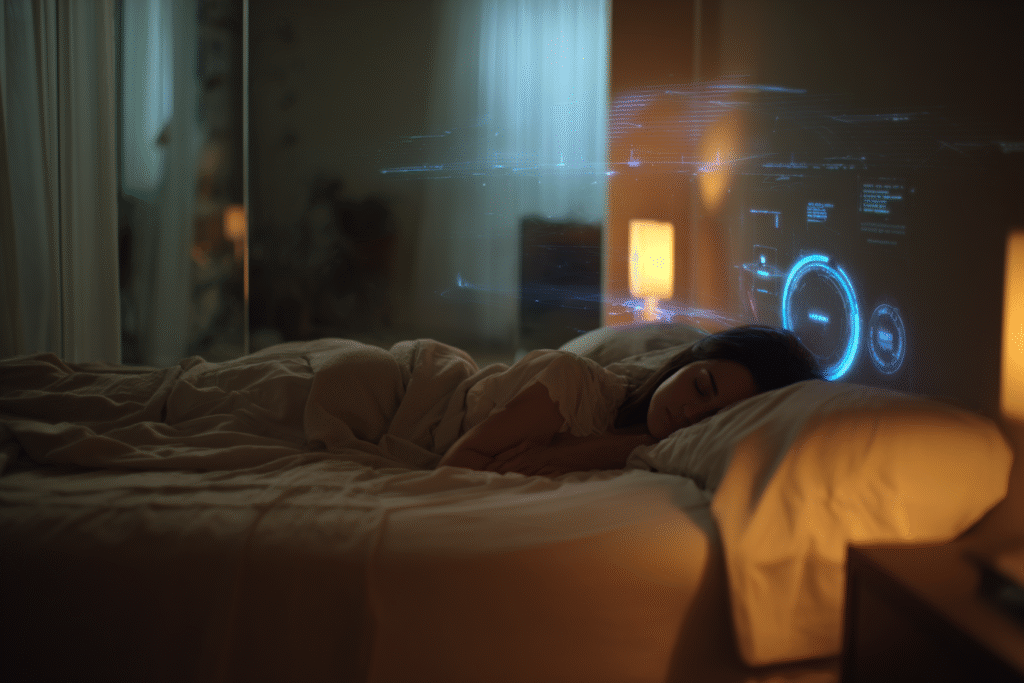
Understanding Sleep Architecture
To optimize sleep, we must first understand what we’re optimizing. Sleep isn’t a uniform state of unconsciousness but rather a complex, cyclical process involving four distinct stages that serve different biological functions [1].
Sleep occurs in two primary phases: non-rapid eye movement (NREM) sleep, which includes three stages, and rapid eye movement (REM) sleep [11]. Each night, the body cycles through these stages approximately 4 to 6 times, with each complete cycle lasting about 90 minutes [12].
The Four Stages of Sleep
Stage 1 (N1) – Light Sleep: This transitional stage typically lasts 1-7 minutes as you drift from wakefulness to sleep [11]. Brain activity begins to slow, and you can be easily awakened. While brief, this stage is crucial for initiating the sleep cycle.
Stage 2 (N2) – Deeper Sleep: Comprising about 45% of total sleep time, this stage features distinctive brain wave patterns called sleep spindles and K-complexes [11]. Your heart rate and body temperature drop, and your brain begins important memory consolidation processes.
Stage 3 (N3) – Deep Sleep: Often called slow-wave sleep, this is the most restorative stage, making up about 25% of sleep in adults [11]. During N3, your body releases growth hormone, repairs tissues, strengthens the immune system, and consolidates memories. This stage is critical for feeling refreshed upon waking [12].
It’s the night shift crew rebuilding your body, brick by brick, while you’re off in dreams.
REM Sleep: Rapid eye movement sleep typically begins about 90 minutes after falling asleep and increases in duration throughout the night [11]. REM is essential for cognitive functions, emotional processing, creativity, and learning. Adults spend approximately 20-25% of sleep time in REM [11].
Knowing the blueprint is step one—now we align it with the master clock that times every process in your body.
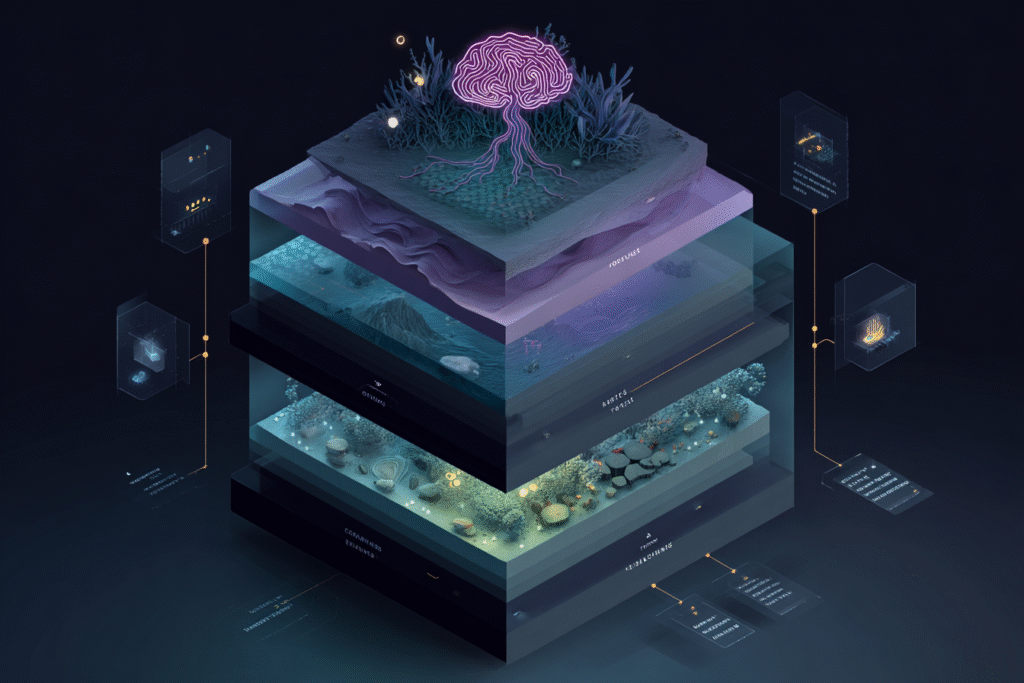
The Circadian Foundation
Your body runs on a master clock — a built-in 24-hour timing system that decides when every process peaks or powers down. Ignore its cues, and even perfect sleep hygiene will fail.
Located in the suprachiasmatic nucleus of the hypothalamus, this master clock coordinates hormone release, body temperature fluctuations, and sleep-wake cycles based primarily on light exposure [14].
The key hormones in this system work in opposition: cortisol naturally peaks in the morning to promote wakefulness and energy [15], while melatonin rises in the evening to signal sleep preparation.
Understanding this foundation allows us to work with rather than against our biology. Many sleep problems stem from disrupting these natural rhythms through inconsistent schedules, inappropriate light exposure, or poor timing of activities that influence circadian biology.
Your circadian clock is the motherboard; light is its primary power supply.
With the clock in view, the next lever is the room itself—because your environment can either fight your biology or make great sleep almost automatic.
Creating Your Sleep Sanctuary
Your bedroom is either a launchpad for deep, restorative sleep — or a sabotage chamber. The difference comes down to a handful of controllable factors. Studies have found that optimizing bedroom environment for temperature, noise, and light levels directly improves sleep quality and duration [16].
Temperature Optimization
The ideal bedroom temperature for most adults is between 65-68°F (18.3-20°C) [13]. This isn’t arbitrary—your body’s core temperature naturally drops 1-2 degrees as part of sleep initiation. A cooler environment supports this natural thermoregulation process and helps you both fall asleep faster and maintain deeper sleep [13].
Even small nighttime temperature increases fragment sleep and cut into slow‑wave and REM cycles, leading to more awakenings and lower sleep efficiency [13].
Think of your body as high-performance hardware — overheat it, and the whole system throttles back.
Practical temperature optimization strategies include:
- Setting programmable thermostats to drop temperature before bedtime: helps you fall asleep faster and stay asleep longer.
- Using breathable, moisture-wicking bedding materials: reduces overheating and mid‑night awakenings.
- Considering cooling mattress toppers or sleep systems for hot sleepers: targets core temperature without over‑cooling the room.
- Taking a warm bath 1-2 hours before bed to encourage natural body cooling [13]: induces a rebound cooling effect that speeds sleep onset.
- Using fans for air circulation without over-cooling: keeps skin temperature stable across the night.
The hum of the fan, the feel of cool sheets — your brain reads these as permission to shut down for the night.

Light Management
Light is the most powerful environmental cue for your circadian rhythm [14]. Exposure to bright light, especially blue light, in the evening suppresses melatonin production and delays sleep onset.
Creating optimal light conditions involves both minimizing problematic light and strategically using beneficial light:
Evening Light Minimization:
- Installing blackout curtains or room-darkening shades
- Using blue light filters on electronic devices after sunset
- Replacing bright overhead lighting with dim, warm-toned lamps
- Avoiding electronic devices at least 30-60 minutes before bedtime [6]
Morning Light Optimization:
- Getting bright light exposure within the first hour of waking [4]: locks in tonight’s bedtime.
- Opening curtains immediately upon rising: amplifies the wake signal.
- Considering light therapy devices if natural light is insufficient: stabilizes circadian timing in low‑light seasons.
- Spending time outdoors in natural sunlight when possible: improves mood and sleep drive later.
When I started getting sunlight within 20 minutes of waking, my mid-morning coffee became optional. My body’s own chemistry was doing the heavy lifting.
Sound Engineering
Even low-level noise can cause shifts to lighter sleep stages and increase the number of brief awakenings, even if you don’t remember waking up [16]. Creating a consistently quiet environment or masking disruptive sounds is crucial for sleep optimization.
Sound optimization strategies include:
- Using high-quality earplugs for light sleepers
- Installing white noise machines or apps to mask variable sounds
- Addressing household noise sources like vibrating appliances or squeaky floors [20]
- Creating physical sound barriers through strategic furniture placement
- Communicating with household members about quiet hours
When your space goes quiet, your nervous system finally hears the signal it’s been waiting for — the one that says, “We’re safe. It’s time to let go.”
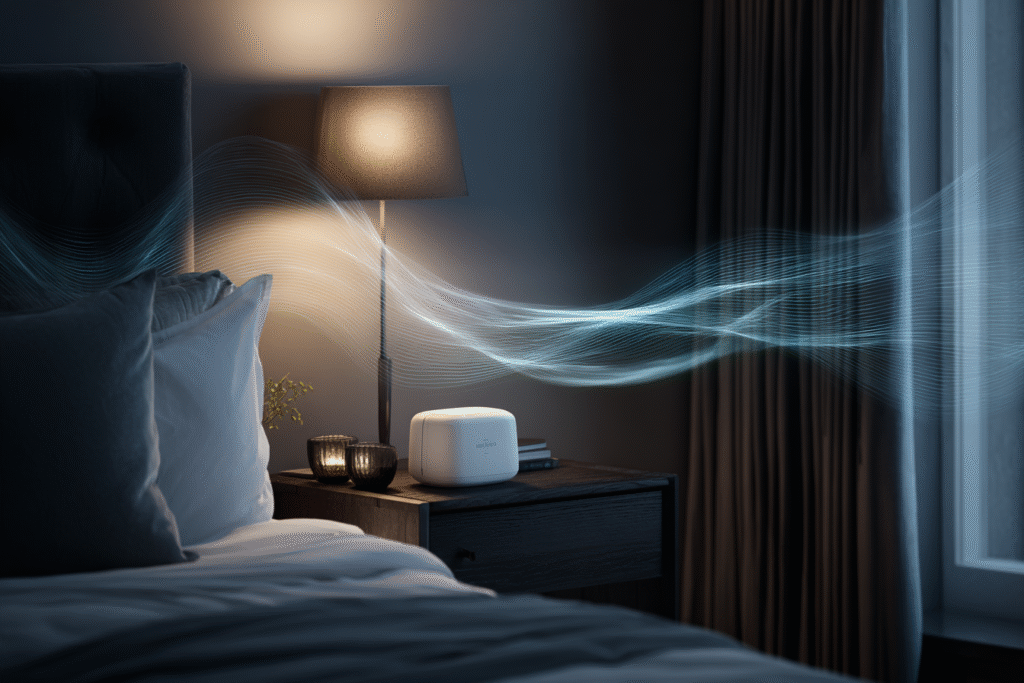
Air Quality and Ventilation
Research has found that better ventilation and fresher air is associated with improved sleep quality [16]. Poor air quality can affect breathing patterns and sleep comfort.
Air quality optimization includes:
- Using air purifiers to remove allergens, dust, and pollutants
- Ensuring adequate bedroom ventilation without creating drafts
- Managing humidity levels between 40-60% for optimal comfort
- Using houseplants that naturally improve air quality [18]
- Regular cleaning to minimize dust and allergen accumulation
Environment set—now time your light, movement, and meals so your biology wants to sleep when you do.
Circadian Biology Management
Optimizing sleep requires understanding and managing the biological processes that drive sleep-wake cycles. This goes beyond just avoiding caffeine—it involves strategically timing activities and exposures to support healthy circadian function.
Light Exposure Timing
Morning Light (6-10 AM) helps set your circadian rhythm and promotes alertness [4]. This is particularly important if you struggle with morning grogginess or have a tendency toward later bedtimes.
Midday Light: Natural sunlight during the day helps maintain circadian stability and supports evening melatonin production.
Evening Light Management: Light exposure in the evening, particularly blue light from screens, can shift your circadian rhythm later and interfere with sleep onset [6].
Exercise Timing
Regular physical activity improves sleep quality and can help regulate circadian rhythms, but timing matters [4]. Exercise raises body temperature and alertness, so vigorous exercise within 2-4 hours of bedtime may interfere with sleep onset for some people.
Optimal exercise timing for sleep:
- Morning or early afternoon exercise tends to support better sleep: supports deeper slow‑wave sleep at night.
- Evening exercise can work for some people but should be completed at least 3-4 hours before bedtime: prevents residual arousal at lights‑out.
- Light stretching or yoga in the evening can actually promote relaxation: activates parasympathetic recovery.
- Consistency in exercise timing helps reinforce circadian rhythms: reinforces circadian regularity.
A friend of mine swapped their 8 PM workouts for lunch breaks and reported falling asleep noticeably faster—from roughly 25 minutes to about 15 minutes—within a week.
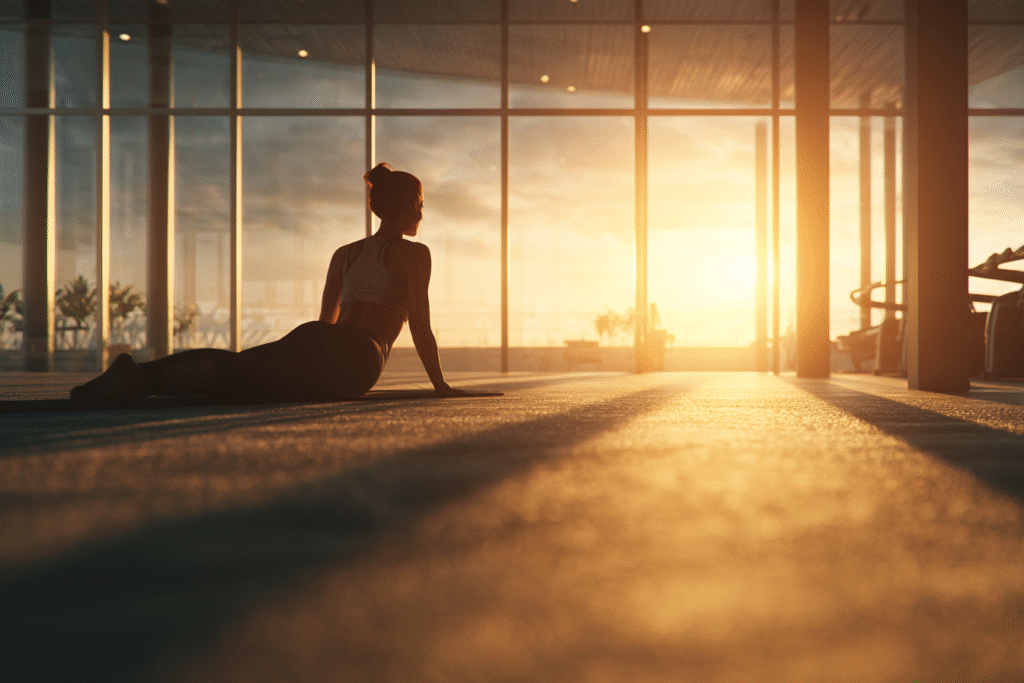
Meal Timing and Composition
Your last meal of the day can be a gentle hand guiding you to sleep — or a noisy neighbor banging on your brain’s door at midnight.
Sleep-supporting nutrition timing:
- Avoiding large meals within 3 hours of bedtime to prevent digestive interference: reduces reflux and nocturnal awakenings.
- Limiting spicy or acidic foods in the evening that might cause discomfort: prevents micro‑arousals from discomfort.
- Including foods that support melatonin production (cherries, nuts, oats): subtly nudges sleep onset.
- Managing caffeine timing—avoiding caffeine at least 8 hours before bedtime [2]: protects total sleep time.
- Considering light, protein-rich snacks if hungry before bed: prevents 2 AM wake‑ups from blood sugar dips.
Daily inputs mastered? Next, neutralize the usual saboteurs so your sleep architecture stays intact.
I once tracked a month of late-night heavy dinners — every night’s data showed spiking heart rate, restless sleep, and groggy mornings. Shifting those meals earlier flipped the trend within days.
Substance Timing for Sleep Optimization
A single poorly timed coffee, drink, or cigarette can undo hours of careful sleep prep. Here’s how each of these hidden saboteurs works — and how to defuse them. Understanding these effects allows for strategic decision-making about timing and consumption.
You can get every environmental and circadian factor right — and still ruin your night with the wrong substance at the wrong time. These three are the most common culprits, and they work faster than you think.
Caffeine: Timing Is Everything
Caffeine reliably shortens total sleep time and lowers sleep efficiency while increasing time to fall asleep and wake‑after‑sleep‑onset [2]. With a 3–7 hour half‑life, a 2 PM coffee can still be active at 9–11 PM [2]. It’s like leaving a power tool running in the next room — the hum never lets your system truly rest.
As a starting point, try setting your personal caffeine curfew to 8–9 hours before bedtime, then adjust based on your individual response.
The individual variation in caffeine sensitivity is significant. Some people metabolize caffeine much faster due to genetic differences, while others may need to avoid it entirely after noon to prevent sleep interference.
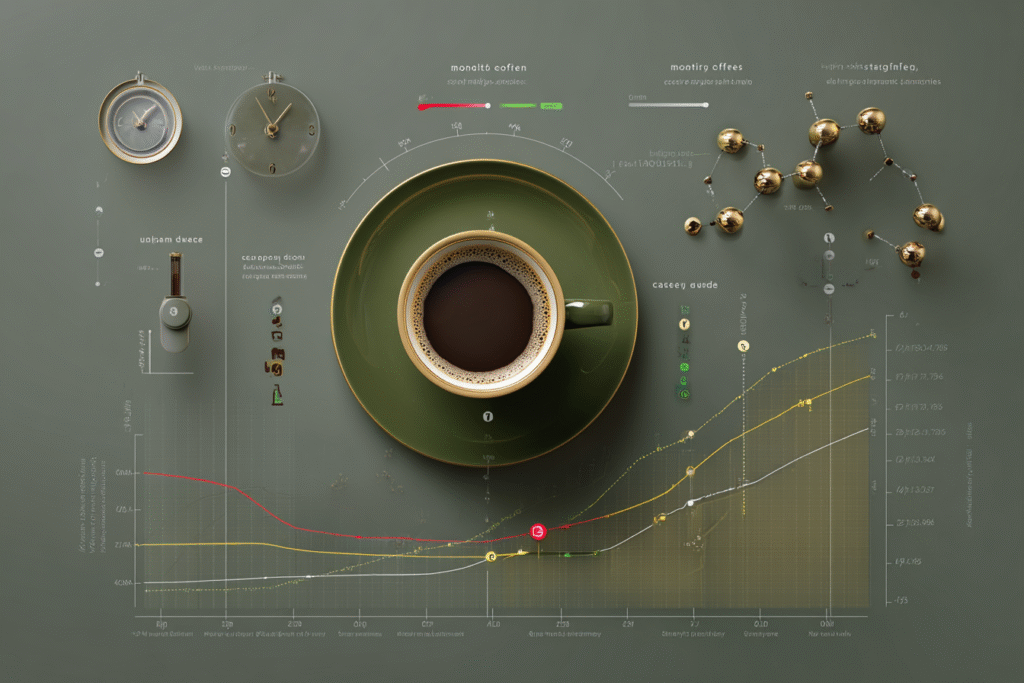
Alcohol: The Sleep Disruptor
Alcohol may make you drowsy at first. But inside your brain, it’s dismantling deep sleep: reduced efficiency, fragmented cycles, and suppressed early‑night REM with a choppy rebound later [3]. As a rule of thumb, leave 4+ hours between your last drink and lights‑out.
Nicotine: The Stimulant in Disguise
Nicotine is a stealth stimulant at night—lower sleep efficiency, longer time awake after sleep onset, and shorter total sleep time, especially in insomniacs [3][17]. Avoid within 4+ hours of bedtime; if you’re quitting, expect temporary sleep volatility and plan wind‑down buffers.
Nicotine affects sleep through multiple mechanisms: as a stimulant, it increases alertness; as an addictive substance, withdrawal symptoms can cause nighttime awakenings; and it can worsen breathing disorders that impact sleep quality [17].
Advanced Sleep Optimization Strategies
Once the basics are solid, it’s time to play in the fine margins — where small, targeted changes unlock the deepest, most restorative sleep of your life.
Sleep Restriction and Consolidation
For people with poor sleep efficiency, sleep restriction therapy involves initially limiting time in bed to match actual sleep time, then gradually expanding as efficiency improves [5]. This technique helps consolidate sleep and reduce the time spent lying awake in bed.
Temperature Manipulation
Advanced temperature strategies go beyond simply keeping the room cool:
- Thermal rhythm management: Using temperature fluctuations to reinforce circadian rhythms
- Targeted cooling: Using cooling devices for specific body parts (head, neck, feet)
- Pre-sleep warming: Strategic warming followed by cooling to promote sleep onset
For example, taking a warm shower 90 minutes before bed, then entering a cool room, can accelerate the natural temperature drop that triggers sleepiness.
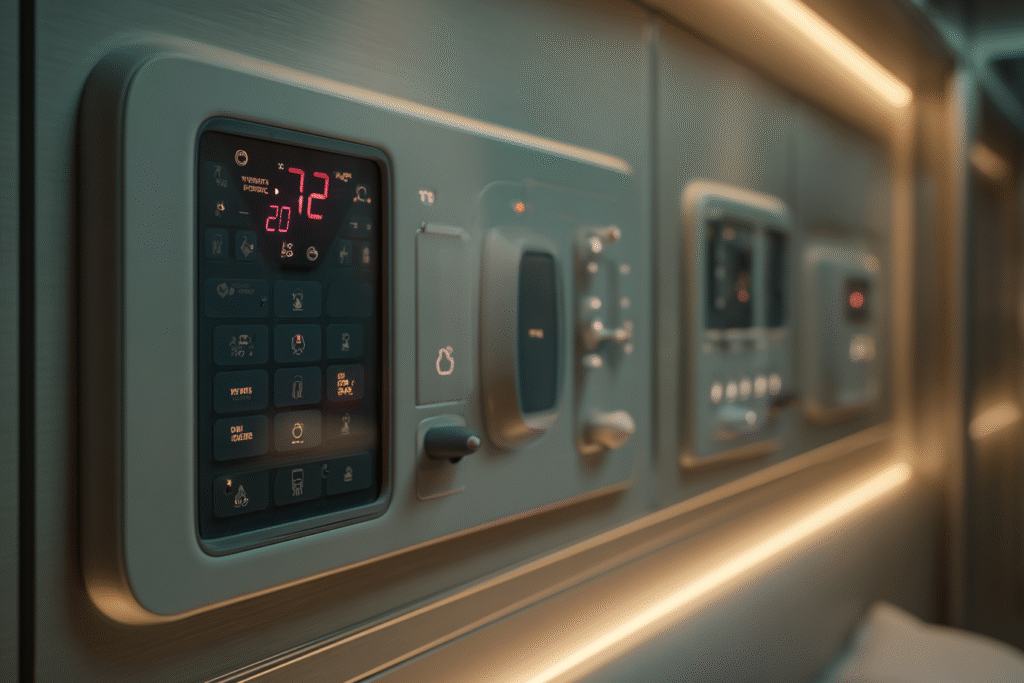
Technology Integration
Modern sleep technology can provide valuable insights and support optimization efforts [20]:
- Sleep tracking devices: Monitoring sleep stages, heart rate variability, and environmental factors
- Smart thermostats: Automatically adjusting temperature throughout the night
- Light therapy devices: Providing targeted light exposure to support circadian rhythms
- Sound machines: Advanced white noise or nature sound systems
Cognitive and Behavioral Interventions
Cognitive Behavioral Therapy for Insomnia (CBT-I) represents the gold standard for addressing persistent sleep problems [5] through:
- Sleep hygiene education: Understanding factors that promote and impair sleep
- Stimulus control: Associating the bed and bedroom with sleep only
- Cognitive restructuring: Addressing anxiety and unrealistic expectations about sleep
- Relaxation training: Progressive muscle relaxation, breathing techniques, mindfulness
With these fundamentals and advanced tools mastered, let’s systematize implementation into a progressive framework you can actually run—stepwise, measurable, adaptable.
Building Your Personal Sleep Architecture
Creating an effective sleep optimization system requires systematic implementation and ongoing refinement. Start with foundational elements and gradually add advanced strategies.

Phase 1: Foundation Building (Weeks 1-2)
Environmental Optimization:
- Set consistent bedroom temperature between 65-68°F
- Install blackout curtains or use sleep masks
- Address noise issues with earplugs or white noise
- Remove electronic devices from bedroom
Circadian Support:
- Establish consistent sleep and wake times, even on weekends [4]
- Get bright light exposure within 1 hour of waking [4]
- Avoid caffeine after 2 PM initially (adjust based on response) [2]
- Create a 30-60 minute pre-sleep routine
Tonight Playbook (5 Minutes):
-
Set bedroom to 66°F.
-
Place phone to charge outside the bedroom.
-
Choose a warm lamp for post‑sunset light.
-
Set a wind‑down alarm for 60 minutes before bed.
-
Put a notepad by the bed for a 2‑minute “brain dump.”
Phase 2: Refinement (Weeks 3-4)
Advanced Environmental Control:
- Fine-tune temperature preferences within the optimal range
- Experiment with different bedding materials for temperature regulation
- Optimize air quality with ventilation or air purification
- Test different sound environments (complete silence vs. white noise)
Circadian Precision:

Phase 3: Advanced Optimization (Weeks 5-8)
Substance Strategy:
- Eliminate alcohol within 4 hours of bedtime [3]
- If using nicotine, avoid within 4 hours of sleep [17]
- Consider natural sleep support supplements (melatonin, magnesium) with medical guidance
- Evaluate prescription medications that might affect sleep
Technology Integration:
Phase 4: Personalization and Mastery (Ongoing)
Individual Optimization:
- Identify your personal chronotype and optimal sleep-wake timing
- Adjust strategies based on life changes, seasons, and aging [4]
- Develop strategies for travel and schedule disruptions
- Create backup plans for maintaining sleep quality during stress
Continuous Improvement:
- Regular assessment of sleep quality and daytime function
- Adjustment of strategies based on changing needs and circumstances
- Professional consultation for persistent sleep issues [7]
- Integration of new research and technology as available
With a living system in place, you’re ready to harvest the downstream gains across health, cognition, and emotion.
Sleep as Health Infrastructure
Optimal sleep isn’t just about feeling rested—it’s about creating the foundation for peak performance in every area of life. Quality sleep enhances immune function, emotional regulation, cognitive performance, and even spiritual well-being [8].
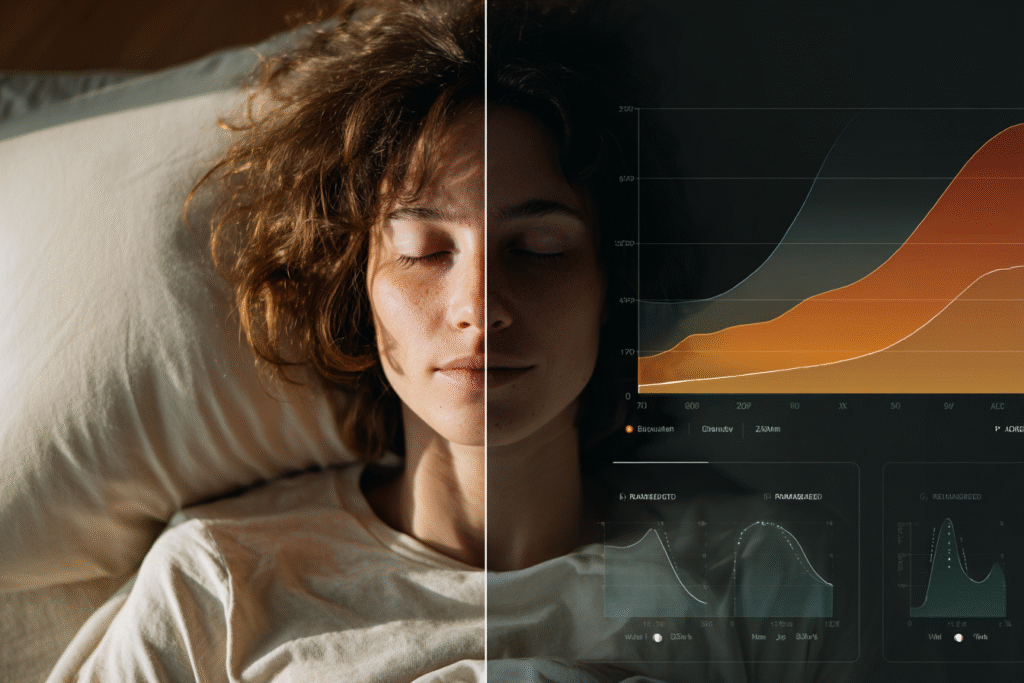
Physical Health Integration
Sleep serves as the critical recovery period when your body repairs tissues, releases growth hormone, and strengthens immune function [7]. Consistent, high-quality sleep reduces inflammation, supports healthy metabolism, and enhances physical performance [8].
Integration strategies:
Cognitive Performance Integration
Sleep is essential for memory consolidation, creative problem-solving, and decision-making [1]. REM sleep specifically supports learning and emotional processing, while deep sleep consolidates memories and clears metabolic waste from the brain [11].
Integration strategies:
Emotional and Spiritual Integration
Sleep profoundly affects emotional regulation, stress resilience, and our capacity for meaningful connection with others and our deeper purpose. Poor sleep undermines our ability to respond thoughtfully rather than reactively to life’s challenges.
Integration strategies:
- Recognize sleep’s role in emotional stability and relationship quality
- Use improved sleep as a foundation for stress management practices
- Consider how sleep quality affects your ability to engage with spiritual or meaningful activities
- View sleep optimization as an act of self-respect and care for others who depend on you

Measuring Success: Beyond Hours Slept
Track outputs, not just hours—if the day feels and performs better, your night is working. In tech terms, hours are just uptime — what matters is performance under load.
True sleep optimization success goes beyond simply logging eight hours. Quality metrics include sleep efficiency (percentage of time in bed actually spent sleeping), sleep latency (time to fall asleep), number of nighttime awakenings, and most importantly, how you feel and function during the day [7].
Subjective Measures
- Morning Energy: Waking naturally without extreme grogginess
- Daytime Alertness: Sustained energy without excessive caffeine dependence
- Emotional Stability: Better stress resilience and emotional regulation
- Cognitive Function: Improved focus, memory, and decision-making
- Physical Performance: Enhanced exercise capacity and recovery
Objective Measures
- Sleep Efficiency: Aim for 85%+ (time asleep ÷ time in bed)
- Sleep Latency: Falling asleep within 10-20 minutes consistently
- Sleep Continuity: Minimal awakening and quick return to sleep
- Sleep Architecture: Age‑appropriate distribution of stages (deep sleep naturally declines slightly with age)
- Circadian Consistency: Stable sleep‑wake timing
Sleep as Competitive Advantage
In a world where many people operate on insufficient or poor-quality sleep, optimizing your sleep architecture creates a genuine competitive advantage. Better sleep improves every aspect of performance while reducing healthcare costs and enhancing quality of life [8].
It’s the system upgrade that makes every other app on your life’s dashboard run smoother.
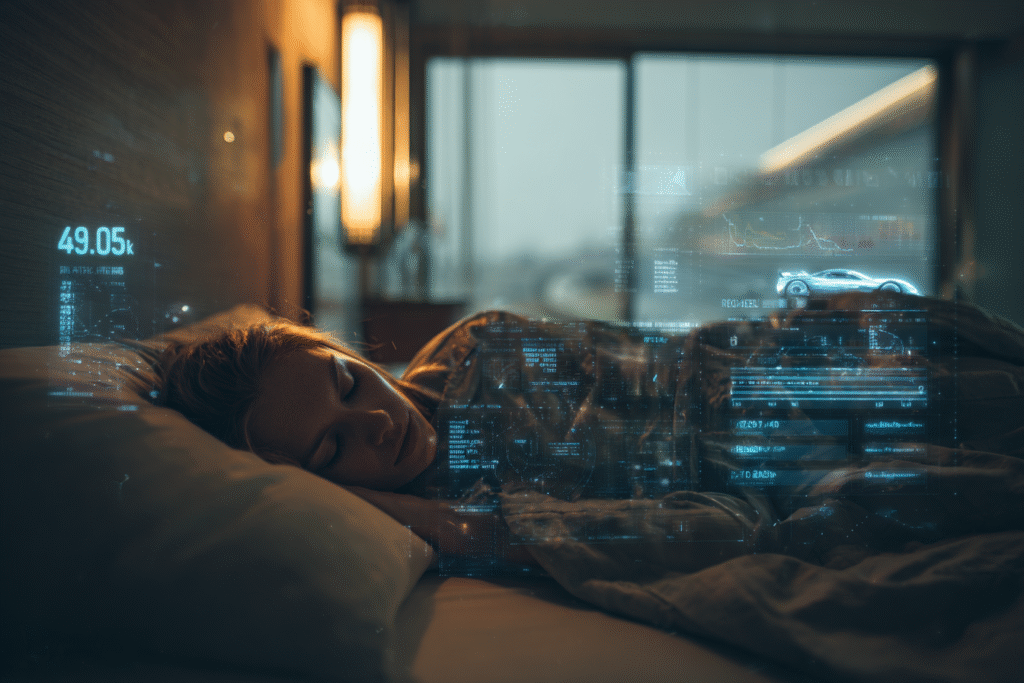
Consider sleep optimization not as another item on your self-improvement list, but as the foundation that makes everything else possible. When you sleep well consistently, you’re more creative, more resilient, more empathetic, and more capable of making the kinds of decisions that create the life you actually want [9].
In a sleep-deprived world, being well-rested is a kind of superpower — one that sharpens every decision, conversation, and creative leap you make.
The investment in sleep architecture pays dividends across every domain of life. You become more present with family and friends, more effective at work, more capable of handling stress, and more aligned with your deeper values and purpose. This isn’t about perfection—it’s about creating sustainable systems that honor one of your most fundamental biological needs.
Sleep optimization is ultimately an act of wisdom: rest isn’t the enemy of productivity—it’s the engine. In a culture that glorifies exhaustion, choosing sleep is a quiet form of leadership that lifts your health, your work, and everyone who relies on you.
Treat sleep like what it is: foundational technology. Design it, run it, and refine it—then let the results compound in your body, your mind, and your life.
In the end, sleep isn’t time lost — it’s the invisible work that makes everything else possible.
See you in the next insight.
Comprehensive Medical Disclaimer: The insights, frameworks, and recommendations shared in this article are for educational and informational purposes only. They represent a synthesis of research, technology applications, and personal optimization strategies, not medical advice. Individual health needs vary significantly, and what works for one person may not be appropriate for another. Always consult with qualified healthcare professionals before making any significant changes to your lifestyle, nutrition, exercise routine, supplement regimen, or medical treatments. This content does not replace professional medical diagnosis, treatment, or care. If you have specific health concerns or conditions, seek guidance from licensed healthcare practitioners familiar with your individual circumstances.
References
The references below are organized by study type. Peer-reviewed research provides the primary evidence base, while systematic reviews synthesize findings.
Peer-Reviewed / Academic Sources
- [1] Patel, A. K., Reddy, V., & Araujo, J. F. (2024) Physiology, sleep stages. StatPearls. https://www.ncbi.nlm.nih.gov/books/NBK526132/
- [2] ScienceDirect (2023) The effect of caffeine on subsequent sleep: A systematic review and meta-analysis. https://www.sciencedirect.com/science/article/pii/S1087079223000205
- [3] PMC (2019) Evening intake of alcohol, caffeine, and nicotine: night-to-night associations with sleep duration and continuity. https://pmc.ncbi.nlm.nih.gov/articles/PMC6802565/
- [4] Harvard Health (2025) Sleep hygiene: Simple practices for better rest. https://www.health.harvard.edu/staying-healthy/sleep-hygiene-simple-practices-for-better-rest
- [5] AASM Foundation (2024) SLEEP 2024 Insomnia Implementation Science Session. https://foundation.aasm.org/event/sleep-2024-insomnia-implementation-science-session/
Government / Institutional Sources
- [6] CDC (2025) About Sleep. https://www.cdc.gov/sleep/about/index.html
- [7] NCBI Bookshelf (2024) Sleep Physiology – Sleep Disorders and Sleep Deprivation. https://www.ncbi.nlm.nih.gov/books/NBK19956/
Industry / Technology Sources
- [8] Walker, M. (2017) Why We Sleep: Unlocking the Power of Sleep and Dreams. Scribner. https://www.amazon.com/Why-We-Sleep-Unlocking-Dreams/dp/1501144316
- [9] Walker, M. UC Berkeley Center for Human Sleep Science. Research on sleep and immune function. https://vcresearch.berkeley.edu/faculty/matthew-walker
- [10] Walker, M. (2018) The Matt Walker Podcast: Sleep research findings. https://findingmastery.com/podcasts/matthew-walker/
- [11] Sleep Foundation (2021) Stages of Sleep: What Happens in a Normal Sleep Cycle. https://www.sleepfoundation.org/stages-of-sleep
- [12] Cleveland Clinic (2025) Sleep: What It Is, Why It’s Important, Stages, REM & NREM. https://my.clevelandclinic.org/health/body/12148-sleep-basics
- [13] Sleep Foundation (2020) The Best Temperature for Sleep. https://www.sleepfoundation.org/bedroom-environment/best-temperature-for-sleep
- [14] Cleveland Clinic (2024) Circadian Rhythm: What It Is, How It Works & What Affects It. https://my.clevelandclinic.org/health/articles/circadian-rhythm
- [15] ZRT Laboratory The Role of Cortisol and Melatonin in the Synchronization of the Circadian Rhythm. https://www.zrtlab.com/blog/archive/cortisol-and-melatonin-in-the-circadian-rhythm/
- [16] Sleep Foundation (2023) How to Design the Ideal Bedroom for Sleep. https://www.sleepfoundation.org/bedroom-environment/how-to-design-the-ideal-bedroom-for-sleep
- [17] Sleep Foundation (2023) The Relationship Between Nicotine and Sleep. https://www.sleepfoundation.org/physical-health/nicotine-and-sleep
- [18] Scientific American (2024) Science-Backed Sleep Tips from 2024 to Help You Snooze Better. https://www.scientificamerican.com/article/science-backed-sleep-tips-from-2024-to-help-you-snooze-better/
- [19] Eight Sleep How the Eight Sleep community achieved sleep fitness in 2024. https://www.eightsleep.com/blog/eoy-2024/
- [20] National Sleep Foundation (2024) Technology and Sleep. https://www.thensf.org/technology-and-sleep/


